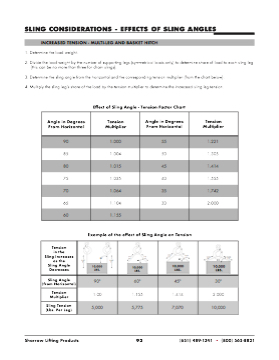SLING CONSIDERATIONS - EFFECTS OF SLING ANGLES INCREASED TENSION - MULTI-LEG AND BASKET HITCH 1. Determine the load weight. 2. Divide the load weight by the number of supporting legs (symmetrical loads only) to determine share of load to each sling leg (this can be no more than three for chain slings). 3. Determine the sling angle from the horizontal and the corresponding tension multiplier (from the chart below). 4. Multiply the sling leg’s share of the load by the tension multiplier to determine the increased sling leg tension. E ect of Sling Angle - Tension Factor Chart Angle in Degrees From Horizontal Tension Multiplier Angle in Degrees From Horizontal Tension Multiplier 90 1.000 55 1.221 85 1.004 50 1.305 80 1.015 45 1.414 75 1.035 40 1.555 70 1.064 35 1.742 65 1.104 30 2.000 60 1.155 Example of the e ect of Sling Angle on Tension Tension in the Sling Increases as the Sling Angle Decreases 7.070 LBS. 7.070.. LBS. Sling Angle (from Horizontal) Sling Tension (Lbs. Per Leg) 90° 1.00 5,000 5.775 LBS. 5.775 LBS. 5,000 LBS. 5,000 LBS. 90° 10,000 LBS. 60° 1.155 5,775 45° 7,070 45° 10,000 10,000 LBS. LBS. 30° 10,000 LBS. 60° 10,000 LBS. D 10,000 LBS. 30° Tension Multiplier 1.414 2.000 10,000 Sharrow Lifting Products 93 (651) 489-1341 • (800) 565-8821
